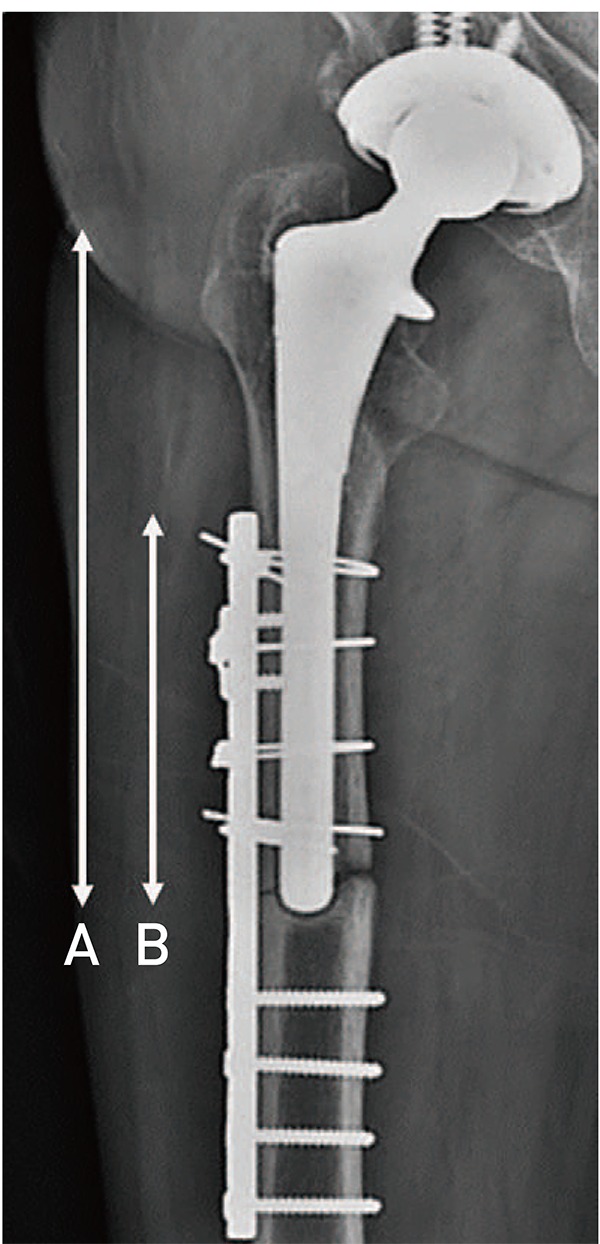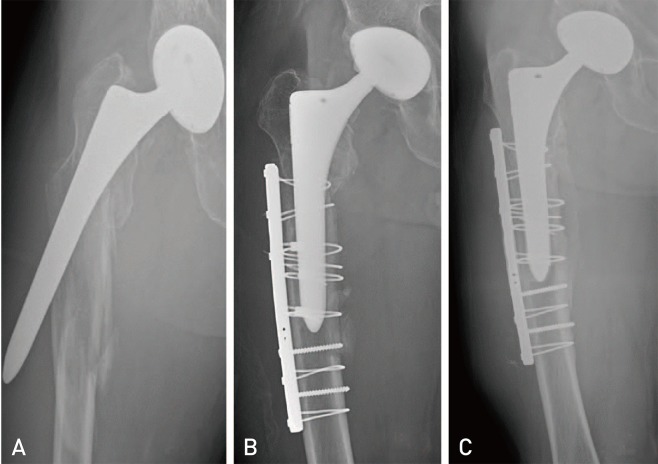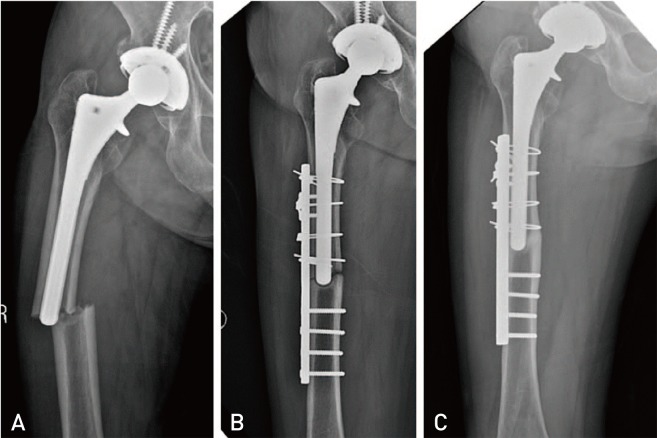Hip Pelvis.
2019 Sep;31(3):166-173. 10.5371/hp.2019.31.3.166.
Prognostic Factors and Clinical Outcomes after Treatment of Periprosthetic Femoral Fractures Using a Cable-plate
- Affiliations
-
- 1Department of Orthopaedic Surgery, Inha University Hospital, Incheon, Korea. pparkjoo@naver.com
- 2CM General Hospital, Seoul, Korea.
- KMID: 2455990
- DOI: http://doi.org/10.5371/hp.2019.31.3.166
Abstract
- PURPOSE
To analyze prognostic factors for the treatment of periprosthetic femoral fractures (PFFs) using the cable-plate construct.
MATERIALS AND METHODS
A retrospective review of a consecutive series of 41 PFFs treated by osteosynthesis using the cable-plate system. The mean age of patients was 67.3±12.1 years (range, 42-86 years) and the mean follow-up period was 31.5±11.6 months (range, 12-58 months). Fresh frozen cortical strut allografts were leveraged in three cases for additional stability. Prognostic factors that may potentially affect clinical outcomes were analyzed.
RESULTS
At the time of final follow-up, fracture union was obtained in 29 hips (70.7%; Group I) after an average of 13.5 weeks (range, 12-24 weeks). Healing failure after surgical treatment was observed in 12 cases (29.3%; Group II), including delayed union (n=10) cases and nonunion (n=2). Factors significantly associated with fracture union included fracture pattern (P=0.040), plate overlap percentage to stem length (P<0.001) and T-score at the preoperative bone mineral density (P=0.011). Transverse-type fractures around or just distal to a well-fixed femoral stem were observed in six cases (50.0%) of Group II.
CONCLUSION
The cable-plate osteosynthesis of PFFs should be performed with caution in transverse-type fractures or in cases with severe osteoporosis. Fixation with sufficient plate overlap to stem length may be critical to prevent healing failure.
MeSH Terms
Figure
Reference
-
1. Brand S, Ettinger M, Omar M, Hawi N, Krettek C, Petri M. Concepts and potential future developments for treatment of periprosthetic proximal femoral fractures. Open Orthop J. 2015; 9:405–411. PMID: 26401164.
Article2. Campbell P, McWilliams TG. Periprosthetic femoral fractures. Curr Orthop. 2002; 16:126–132.
Article3. Kim MW, Chung YY, Lee JH, Park JH. Outcomes of surgical treatment of periprosthetic femoral fractures in cementless hip arthroplasty. Hip Pelvis. 2015; 27:146–151. PMID: 27536618.
Article4. Zheng L, Lee WY, Hwang DS, Kang C, Noh CK. Could patient undergwent surgical treatment for periprosthetic femoral fracture after hip arthroplasty return to their status before trauma? Hip Pelvis. 2016; 28:90–97. PMID: 27536650.
Article5. Lindahl H, Malchau H, Herberts P, Garellick G. Periprosthetic femoral fractures classification and demographics of 1049 periprosthetic femoral fractures from the Swedish National Hip Arthroplasty Register. J Arthroplasty. 2005; 20:857–865. PMID: 16230235.6. Lindahl H. Epidemiology of periprosthetic femur fracture around a total hip arthroplasty. Injury. 2007; 38:651–654. PMID: 17477925.
Article7. Lindahl H, Garellick G, Regnér H, Herberts P, Malchau H. Three hundred and twenty-one periprosthetic femoral fractures. J Bone Joint Surg Am. 2006; 88:1215–1222. PMID: 16757753.
Article8. Brady OH, Garbuz DS, Masri BA, Duncan CP. The reliability and validity of the Vancouver classification of femoral fractures after hip replacement. J Arthroplasty. 2000; 15:59–62. PMID: 10654463.9. Xue H, Tu Y, Cai M, Yang A. Locking compression plate and cerclage band for type B1 periprosthetic femoral fractures preliminary results at average 30-month follow-up. J Arthroplasty. 2011; 26:467–471. PMID: 20570098.10. Tadross TS, Nanu AM, Buchanan MJ, Checketts RG. Dall-Miles plating for periprosthetic B1 fractures of the femur. J Arthroplasty. 2000; 15:47–51. PMID: 10654461.
Article11. Park SK, Kim YG, Kim SY. Treatment of periprosthetic femoral fractures in hip arthroplasty. Clin Orthop Surg. 2011; 3:101–106. PMID: 21629469.
Article12. Chun YS, Lee JS, Cho YJ, Rhyu KH. Periprosthetic insufficiency fracture around radiographically loose cemented stem: a report of two cases. Hip Pelvis. 2015; 27:183–186. PMID: 27536623.
Article13. Ricci WM, Bolhofner BR, Loftus T, Cox C, Mitchell S, Borrelli J Jr. Indirect reduction and plate fixation, without grafting, for periprosthetic femoral shaft fractures about a stable intramedullary implant. Surgical technique. J Bone Joint Surg Am. 2006; 88 Suppl 1 Pt 2:275–282. PMID: 16951099.14. Lewis GS, Caroom CT, Wee H, et al. Tangential bicortical locked fixation improves stability in Vancouver B1 periprosthetic femur fractures: a biomechanical study. J Orthop Trauma. 2015; 29:e364–e370. PMID: 26053467.15. Kelley SS. Periprosthetic femoral fractures. J Am Acad Orthop Surg. 1994; 2:164–172. PMID: 10709005.
Article16. Serocki JH, Chandler RW, Dorr LD. Treatment of fractures about hip prostheses with compression plating. J Arthroplasty. 1992; 7:129–135. PMID: 1613518.
Article17. Lever JP, Zdero R, Nousiainen MT, Waddell JP, Schemitsch EH. The biomechanical analysis of three plating fixation systems for periprosthetic femoral fracture near the tip of a total hip arthroplasty. J Orthop Surg Res. 2010; 5:45. PMID: 20653962.
Article18. Wilson D, Frei H, Masri BA, Oxland TR, Duncan CP. A biomechanical study comparing cortical onlay allograft struts and plates in the treatment of periprosthetic femoral fractures. Clin Biomech (Bristol, Avon). 2005; 20:70–76.
Article19. Dennis MG, Simon JA, Kummer FJ, Koval KJ, Di Cesare PE. Fixation of periprosthetic femoral shaft fractures: a biomechanical comparison of two techniques. J Orthop Trauma. 2001; 15:177–180. PMID: 11265007.
Article20. Dennis MG, Simon JA, Kummer FJ, Koval KJ, DiCesare PE. Fixation of periprosthetic femoral shaft fractures occurring at the tip of the stem: a biomechanical study of 5 techniques. J Arthroplasty. 2000; 15:523–528. PMID: 10884215.21. Learmonth ID. The management of periprosthetic fractures around the femoral stem. J Bone Joint Surg Br. 2004; 86:13–19. PMID: 14765858.
Article22. Ehlinger M, Adam P, Moser T, Delpin D, Bonnomet F. Type C periprosthetic fractures treated with locking plate fixation with a mean follow up of 2.5 years. Orthop Traumatol Surg Res. 2010; 96:44–48. PMID: 20170856.
Article23. Schütz M, Müller M, Krettek C, et al. Minimally invasive fracture stabilization of distal femoral fractures with the LISS: a prospective multicenter study. Results of a clinical study with special emphasis on difficult cases. Injury. 2001; 32 Suppl 3:SC48–SC54. PMID: 11888194.
Article24. Kolb W, Guhlmann H, Friedel R, Nestmann H. [Fixation of periprosthetic femur fractures with the less invasive stabilization system (LISS): a new minimally invasive treatment with locked fixed-angle screws]. Zentralbl Chir. 2003; 128:53–59. German. PMID: 12594614.25. Min BW, Cho CH, Son ES, Lee KJ, Lee SW, Min KK. Minimally invasive plate osteosynthesis with locking compression plate in patients with Vancouver type B1 periprosthetic femoral fractures. Injury. 2018; 49:1336–1340. PMID: 29807829.
Article26. Corten K, Vanrykel F, Bellemans J, Frederix PR, Simon JP, Broos PL. An algorithm for the surgical treatment of periprosthetic fractures of the femur around a well-fixed femoral component. J Bone Joint Surg Br. 2009; 91:1424–1430. PMID: 19880884.
Article27. Howell JR, Masri BA, Garbuz DS, Greidanus NV, Duncan CP. Cable plates and onlay allografts in periprosthetic femoral fractures after hip replacement: laboratory and clinical observations. Instr Course Lect. 2004; 53:99–110. PMID: 15116604.
- Full Text Links
- Actions
-
Cited
- CITED
-
- Close
- Share
- Similar articles
-
- Treatment of Periprosthetic Femoral Fractures with Cable Plate
- Periprosthetic Femoral Fractures after Hip Arthroplasty
- Treatment of Vancouver B2 and B3 Periprosthetic Femoral Fractures
- Antibiotic-impregnated Cement Plate for the Treatment of Infected Periprosthetic Femoral Fracture after Cementless Total Hip Arthroplasty: A Case Report
- Treatment of Periprosthetic Femoral Fractures after Hip Arthroplasty




